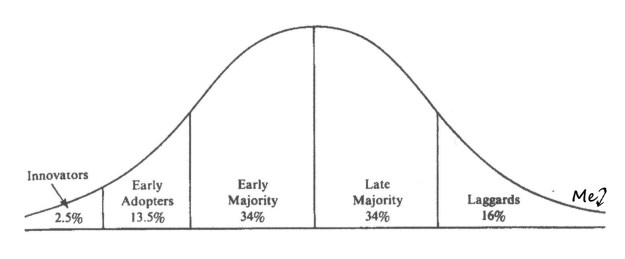29 Jul 2013
Among my friends it is known that I am not one for big changes. I like to keep things the way they are (not taking into account the fact that I migrated to another country). I am also not one to care much for the latest gadgets. I have no digital television, no hands-free in the car, no tablet, no e-book reader, and no smartphone. This has caused many raised eyebrows among people I have met at conferences and project meetings. How can anyone working at the Oxford Internet Institute not be online 24/7? And yes, I probably am one of the very few at the OII who does not own an iPhone or Android phone (although I know of one Research Fellow who doesn’t own a mobile phone at all). In awe I watch people swipe their touch-screens and tilt their applications to change the orientation of the screen from portrait to landscape. I am old-fashioned, I am behind the times. I am the ultimate laggard. The end of the S-curve.
When I interviewed students about privacy issues a couple of weeks ago I asked them a question about their phone use: what kind of phone do you have, and what do you use it for? It turned out all of them had a smartphone and used it for an endless list of applications (e.g. games, directions, texting, Facetime, Skype, downloading music, online banking, etc). However, several of the respondents forgot to mention the phone calls they make and receive, which for me is clearly the primary function of a mobile.
But times are changing. Even for a laggard like me. At the start of my new project I made the decision to change from a Windows laptop to a Mac. I felt it was time to learn how to use a Mac as most of the colleagues I work with have one. Whenever they ask me to do some simple task on their machine I get confused, as I have no idea how to use the touchpad, where to find the close button, or how to copy/paste a bit of text. So now I have been the proud owner of a gorgeous looking MacBook Air for a couple of months. And do I know how to use it yet? Am I typing this blog post on my fancy new apparatus? No. My excuse is that I have been too busy with ‘real’ work to find the time to become confident enough on the Mac to use it for my daily job. I watch BBC iPlayer programmes on it, I check my emails, I take it to project meetings as it is lovely light-weight, and I have been randomly fiddling about with it, but I have yet to create any documents on it or work on anything serious.
Rogers’ Diffusion of Innovations theory attempts to explain which factors will influence the adoption of IT [1]. In order to use new technology end-users need to be convinced of its relative advantage, its ease of use, the way it might enhance their image or status, etc. Well, I don’t need to be convinced of how good-looking the Mac is, it is clear for everyone to see. And I have been told (repeatedly) by Mac-users how much better and more secure it is than any Windows laptop, and how easy it is to use once you get the hang of it. And that is precisely the problem. I think the Mac has quite a steep learning-curve when you have been a lifelong Windows user. It is not like buying a new car, getting in, and being able to drive off immediately because all the basic functions are the same as in any other car you’ve ever driven. It does take time to learn how to use the Mac proficiently, and hopefully I’ll find some time over the summer to get to grips with it.
[1] Rogers, E. M. (2003) Diffusion of Innovations, 6th edition, New York: Free Press.